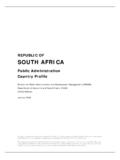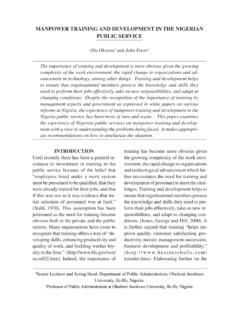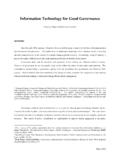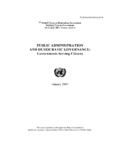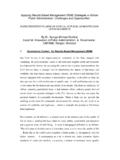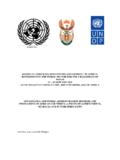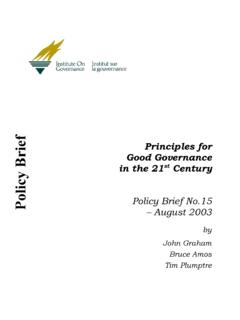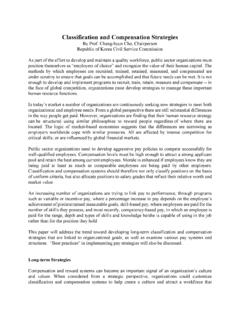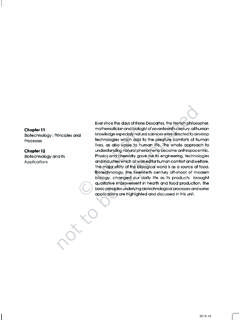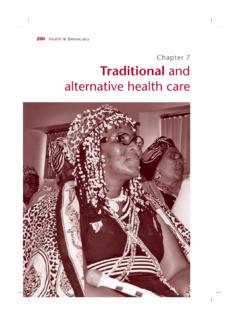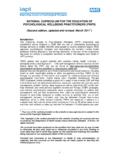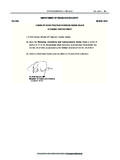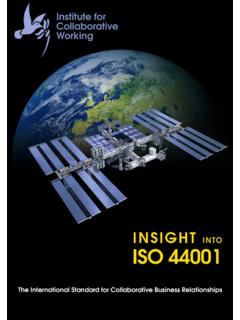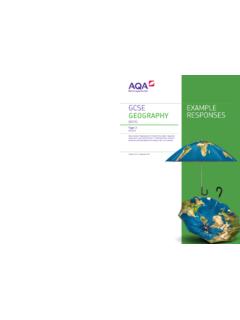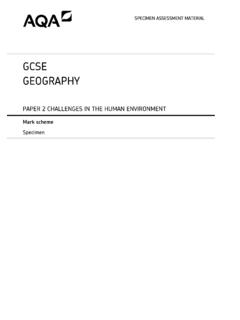Transcription of Local Government Knowledge Management Toolkit (Australia)
1 LOCALGOVERNMENTKNOWLEDGE MANAGEMENTTOOLKITB uilding capacity for integrated Knowledge Management solutionsVersion MANAGEMENTTOOLKITP ublished by:Australian Local Government Association ALGA work is copyright. Apart from any use permitted under the Copyright Act 1968, no part ofthis work may be reproduced by any process without written permission from the AustralianLocal Government Association 8 Geils Court, Deakin ACT 2600 at is granted to copy, distribute and/or modify this document under the terms of theGNU Free Documentation License, Version or any later version published by the FreeSoftware Foundation; with no invariant Sections, no Front-Cover Texts and no Back CoverTexts. A copy of the licence is available on the CD that is part of this data: Local Government Knowledge Management ToolkitBuilding capacity for integrated Knowledge Management solutionsISBN 1 876114 02 09 Version 2004 The information contained in this publication is intended for general use, to assist public Knowledge anddiscussion and to help improve the use of Knowledge Management by Local governments in Australia.
2 Theinformation should not be relied upon for the purpose of a particular matter. Legal advice should be obtainedbefore any action or decision is taken on the basis of any material in this document. The Australian LocalGovernment Association and the authors do not assume liability of any kind whatsoever resulting from anyperson s reliance upon the content of this by Bearcage by Pirion MANAGEMENTTOOLKITiTable of contentsFOREWORDiiACKNOWLEDGEMENTSiiiEXE CUTIVE SUMMARY1 Case Studies4 OTICON4 THE WORLD BANK4 THE RITZ CARLTON HOTEL COMPANY4 PARTONE5 INTRODUCING Knowledge MANAGEMENT5 Module One - WHATIS Knowledge Management ?5 Module Two WHATARE WE CURRENTLY DOING?7 Module Three HOW DO WE FIND Knowledge ?9 Module Four - INTRODUCING KM INTO LOCALGOVERNMENT10 Module Five - Knowledge MAPPING12 Module Six - SELLING Knowledge MANAGEMENT14 Module Seven - KM STRATEGY19 Module Eight - CONSULTATION21 Module Nine - IMPLEMENTATION22 PARTTWO25 IMPLEMENTATION MODULES25 Module Ten - How does the organisation assess Knowledge ?
3 25 ACTION PLAN:26 Module Eleven - How does the organisation acquire Knowledge ?27 ACTION PLAN:28 Module Twelve - How does the organisation build Knowledge ?29 ACTION PLAN:30 Module Thirteen - How does the organisation learn Knowledge ?31 ACTION PLAN:32 Module Fourteen - How does the organisation contribute Knowledge ?33 ACTION PLAN:34 Module Fifteen - How does the organisation use Knowledge ?35 ACTION PLAN:36 BIBLIOGRAPHY37 Knowledge MANAGEMENTTOOLKIT pageiiForewordThe Local Government Knowledge Management Toolkit (the Toolkit ) has been developed tohelp build the capacity of Local Government staff to recognise the opportunities fordiscovering and sharing Knowledge . The Toolkit has been prepared on behalf of the AustralianLocal Government Association to assist Local governments to find, harness, and manage theirknowledge resource. A strategic outcome is to facilitate flows of Knowledge within andbetween councils, and ultimately the community all Local governments serve.
4 The Toolkit canbe used as a text book document, teaching aid or as a series of individual Toolkit has three components:1. Executive SummaryInformation on high-level issues for Local Government managers to consider and to then consider building into business behaviours where appropriate (available inhardcopy, CD and web versions).2. Description of What Knowledge Management is all aboutA guide containing key definitions and Knowledge statements that will help localgovernment managers to determine how well their organisation currently manages its Knowledge resource (available in hardcopy, CD and web versions).3. Technical ModulesThe how-to-guide comprises six modules and a number of checklists. Each of thesemodules will help Local organisations to increase their capacity and success at harvesting the Knowledge within, and potentially available to, their organisation(available in hardcopy, CD and web versions).It is acknowledged that when dealing with capacity building and the issue of knowledgemanagement in Local Government there can be no one-size-fits-all product.
5 The Toolkit hasbeen drafted with this in mind and with the view to providing signposts for all localgovernment organisations, wanting to improve their Knowledge Management . It is alsoimportant to recognise that in many cases each State and Territory may have its owninitiatives in the area of Knowledge Management . In this respect, the Toolkit will complementactivities that may already be being carried out by respective State and Territory jurisdictionsand Local Government users are encouraged to communicate with their respective State and Territory localgovernment associations in order to maximise the full potential that can be gained fromimproved Knowledge Management . Mike MontgomeryPresidentAustralian Local Government AssociationKNOWLEDGE MANAGEMENTTOOLKITiiiAcknowledgmentsThe Australian Local Government Association would like to acknowledge the following people who assisted in assembling the Local Government Knowledge Management Toolkit as a national Government ContributionsNeill HockingWhittlesea City Council Mark DornauYarra City Council Sue CollinsYarra City Council Gary Richardson Clarence City Council John TooheyClarence City Council Kiki MagroCity of Playford Local Government AssociationsCatherine AndersonLocal Government Association of QueenslandAllison HailesWestern Australia Local Government AssociationAndrew KoerbinLocal Government Association of TasmaniaJohn MundyLocal Government Association of South AustraliaJohn Hennessy Municipal Association of VictoriaRoger JayasundaraLocal Government & Shires Association of New South WalesLouise FullerLocal Government Association
6 Of the Northern TerritoryJohn CuthbertsonLocal Government Association of TasmaniaKNOWLEDGE MANAGEMENTTOOLKITivKNOWLEDGE MANAGEMENTTOOLKITKNOWLEDGE MANAGEMENTTOOLKITKNOWLEDGE MANAGEMENTTOOLKITKNOWLEDGE MANAGEMENTTOOLKITA cknowledgmentsNationalRick MolonyAustralian Local Government AssociationSharon TuckeyAustralian Local Government AssociationMalcolm WybrowAustralian Local Government AssociationLance OswaldErgon Energy1 Knowledge MANAGEMENTTOOLKITKNOWLEDGE MANAGEMENTTOOLKITKNOWLEDGE MANAGEMENTTOOLKITE xecutive summaryThe Knowledge Management Toolkit has been developed to help Local governmentorganisations generate value from their intellectual and Knowledge based assets. This value is unlocked when Knowledge is shared across an organisation, among employees and departments and even with other most organisations there are two types of Knowledge assets. The first is information thatthe organisations hold and this can include business plans, client lists and databases.
7 As agood rule of thumb this information can be stored either electronically or on second and much more elusive asset is the Knowledge , skills and experience that is in the heads of employees, which is often the most valuable asset that an organisation major difficulty with unlocking this value is to work out an effective methodology torecognise, generate, share and manage that Knowledge . This Toolkit has been developed to assist your organisation to identify your Knowledge basedassets and details strategies for sharing that Knowledge across your of Knowledge ManagementIn today s information driven economy, organisations uncover the most opportunities andultimately derive the most value from intellectual rather than physical assets. To get themost value from an organisation s intellectual assets, Knowledge must be shared and serve as a foundation for of Knowledge ManagementKnowledge Management is not in itself a goal, it is a tool that enables organisations tooperate efficiently and must be aligned to an organisation s strategic focus.
8 KnowledgeManagement (generally referred to as KM ) can enhance an organisation s effectiveness by: Promoting innovation by encouraging staff to share ideas; Facilitating the flow of ideas within an organisation; Improving customer service through improved response time; Improving staff retention rates by recognising the value of employee Knowledge and rewarding it; and Streamlining operations and reducing costs through the elimination of redundant or unnecessary MANAGEMENTTOOLKIT2 Knowledge MANAGEMENTTOOLKITKNOWLEDGE MANAGEMENTTOOLKITKNOWLEDGE MANAGEMENTTOOLKITE xecutive summaryBarriers to SuccessThe key to Knowledge Management is recognising that it is a cultural issue. Manyorganisations ignore people when designing processes and systems the typical top down approach. In an environment where an individual s Knowledge is valued and rewarded,establishing a culture that values and, most importantly, knows how to apply Knowledge isvital.
9 All employees need to be convinced of the value of KM, particularly as they are beingasked to share their Knowledge and critical issues are: KM strategies should not be driven by technology; IT comes after KM decisions based on who (people), what ( Knowledge ) and why (business objectives); KM strategies should be based upon specific business outcomes; KM strategies need to be constantly reviewed so there is no endpoint to a KM plan; KM strategies need to recognise that not all information is Knowledge and that information overload could be an unwelcome by-product of KM; and KM should be led by people who have a thorough understanding of the organisation s goals and that it is not necessarily a function of the IT ToolkitThis Toolkit has been designed in two parts. Part One offers key definitions and Knowledge statements that will help you to develop thenecessary skills to undertake a Knowledge Management project and to determine how wellyour organisation manages its Knowledge .
10 Part Two contains six modules; by working through these you will help your organisation tomove from being Knowledge blocked to Knowledge centred. The Business CaseKnowledge Management does not lend itself to a classic business case or cost/benefitanalysis but there are theoretical models that seek to facilitate the placing of value onintangible assets such as interested may wish to review the work of Karl-Erik Sveiby ( ),particularly Nokia s Invisible Balance Sheet .What can be provided is a measure of the initial need for, and progressive effect of, KM. The measure of progressive effect will be of particular value to the champion if funding and resources are sought as the program approaches full MANAGEMENTTOOLKITKNOWLEDGE MANAGEMENTTOOLKITKNOWLEDGE MANAGEMENTTOOLKITE xecutive summaryThe checklists given in this document can be taken as a base value for the organisation atthe start of Knowledge Management we are at Level the success of KM implementation requires no more than an improvement in the basefigure with the resultant progression of the organisation to a Level Two such progress yields true value is demonstrated by the full-scale adoption of KMprinciples by most of the world s leading corporations, including Microsoft, major oilcompanies, pharmaceutical companies.
